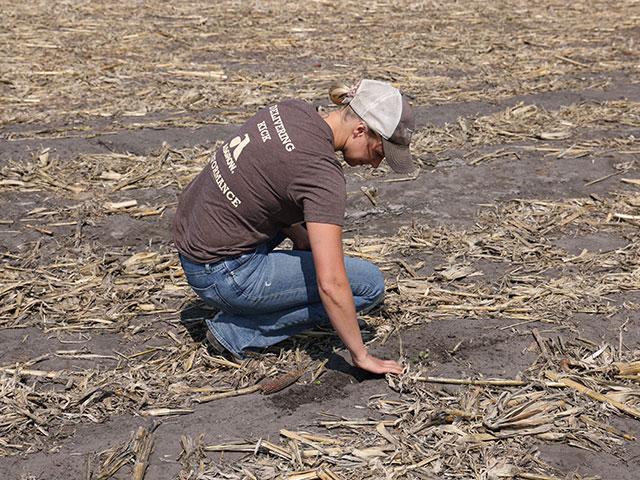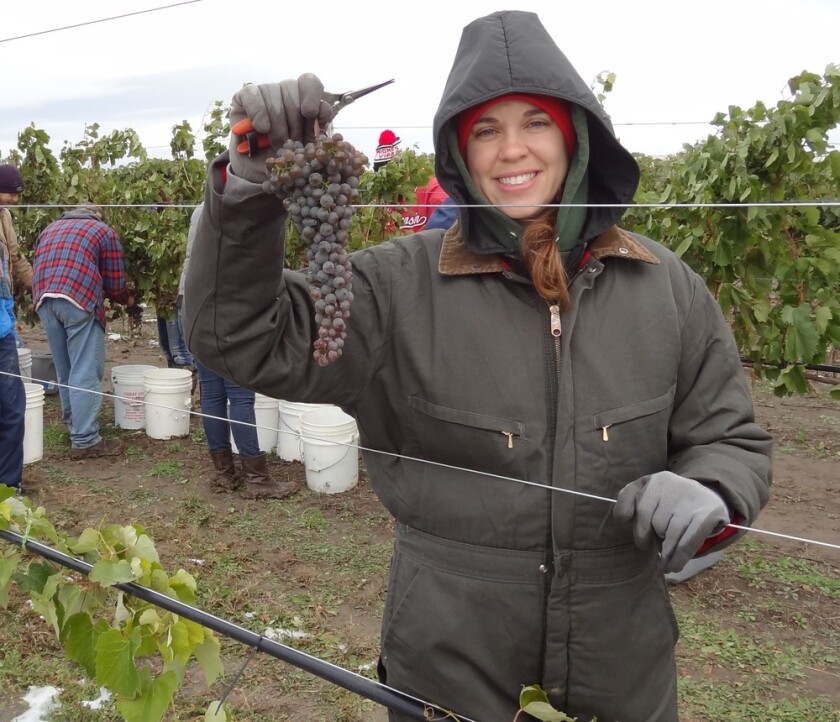North Dakota
Crop Season Rolls Ahead for North Dakota and Missouri Farmers

DTN Ag Meteorologist John Baranick said that this region of Missouri continues to be on the edge of drought, if not in it. “Rain will be harder to come by this coming week,” said Baranick. “Any chances look to hold off until Wednesday, and then they’re around for the rest of the week, but not at any widespread nature.”
Chances for these hit-or-miss rains last well into the following week though and temperatures may be a little lower (80s Fahrenheit are forecast) than in North Dakota, he added.
The latest USDA Crop Progress Report on May 22 pegged Missouri topsoil moisture supply as 11% very short, 27% short, 59% adequate and 3% surplus. Subsoil moisture supply rated 12% very short, 32% short, 53% adequate and 3% surplus. Corn emerged was 88% complete, compared to the five-year average of 65%. Corn condition rated 56% good-to-excellent. Soybeans planted was 74% complete, compared to the five-year average of 37%. Soybeans emerged was 54% complete, compared to the five-year average of 19%.
With planting complete, Trent has been in the sprayer and corn acres have received a postemergence herbicide pass. The local cooperative is hired to broadcast polymer-coated urea and those sidedress applications began this week.
Grossman said a few acres in his area were being replanted after crusting led to spotty stands. “One thing that has really been working for us is to use subsoil ripper to break up compaction, while hardly disturbing the soil surface,” he said.
He has been holding his breath regarding the emergence in one field, though. Grossman said he’s nearly neurotic about checking seed depth, especially as he changes fields. “I had just started planting a new field in the bottoms and crossed a shallow drainage ditch cut with what we call a ‘whirly ditcher.’
“Apparently the planter bounced as I crossed that ditch and ended up knocking the planting depth on one outside row three notches deeper. I’m always getting off and checking to just make sure everything is going right, but that was clear on the far end, and I didn’t check that outside row,” he said. In fact, it wasn’t until the next day when he changed fields that he discovered the error.
“I called my agronomist, and he advised me to wait to see how it emerged. One row throughout a whole field is hard to fix. Fortunately, I planted into near perfect conditions and it’s coming up fine. But it was a valuable lesson — monitors will tell you almost anything — except that you are planting three notches deeper on one row. I think the fact that we have really worked at avoiding subsoil compaction and had a good seed bed saved me,” he added.
With hay and wheat harvest also coming on, Grossman isn’t looking at a lot of downtime this summer. He likes to ride horses but finds it difficult to fit it in regularly. His dog, Sadie, does insist on some fetch each day.
“We’re a real big farming community here and I have a good network of friends of all ages. Farming is what we all do, and it drives almost everything we do. I guess I’m lucky because I like it that way,” he said.
He is planning a vacation this summer of beach time at an all-inclusive resort — a first for this farmer who loves to farm. “That’s going to be interesting to see what that kind of downtime is like,” he said.
CHANDRA AND MIKE LANGSETH: BARNEY, NORTH DAKOTA
It was all hands on deck late this week as the Langseth family made a push to finish planting. Mike Langseth manned the corn planter in fields that had previously been too wet. His father, Paul, was drilling the remaining soybean acres. Chandra, who also teaches agriculture at North Dakota State College of Science in Wahpeton, North Dakota, had finished putting in college test plots and was busy starting to check crop emergence on the home farm.
So far, she’s pleased to find corn emerging fast and uniformly in spring strip-till fields. Their Yetter strip freshener doesn’t build a berm. Instead, coulters move the crop residue off the row and gently till the strip to about 2-to-3 inches deep. Rolling baskets lightly cover the row.
Liquid fertilizer (10 gallon of 28% nitrogen) goes down while making the strip and corn is planted into the strip the next day. Anhydrous is applied as a sidedress operation between the strips starting when the corn is about 4 inches tall.
Last week, when their GPS unit temporarily went down on the strip-till tractor, the couple switched to no-till corn instead of taking the chance of losing the planting window. Those acres will be interesting to track to see if strip-tilling is indeed an advantage.
Statewide the latest USDA Crop Progress Report put North Dakota at 32% planted on corn, ahead of 18% last year, but behind a 50% five-year average. Emerged was 4%, near 1% last year, but behind 11% average. Soybeans planted was 20%, ahead of 6% last year, but behind 33% for the five-year average. Emerged was 1%, near 4% average. Topsoil moisture supplies rated 1% very short, 12% short, 69% adequate, and 18% surplus. Subsoil moisture supplies rated 4% very short, 11% short, 73% adequate, and 12% surplus.
“We tend to complain about it being too wet until we get planted,” Chandra said. “It’s a rare year when we lose substantial yield to drought. Yield losses due to too much moisture is more common.”
Baranick said most of the forecasts suggest showers stay off to the west of the Langseth farming area until Memorial Day. “Likely hit-or-miss type of showers will be around through Wednesday, if not later in the week. Unfortunately, it’s one of those coin-flip type of forecasts. It will stay quite warm there all week with temperatures approaching 90 if the rain holds off,” Baranick said.
Putting the heat to the crop will push other field operations onto the calendar. Weeds such as redroot pigweed and waterhemp seedlings are already showing up in many fields. Most of the fields here are big and square, but those rare irregular areas where it is hard to fit a sprayer boom or water prone areas that escaped good burndown or preemergence coverage are giving a good sample of the weed spectrum. Common lambsquarters are relatively each to control, but there are tougher adversaries such as field horsetail (Equisteum arvense) and scouring rush.
There’s also the need to get rolling on recently planted soybeans. Land rolling is a common soil-finishing practice in this region. It’s been used for decades in alfalfa and grass seed production to improve germination and to manage rocks. There are no rocks on this farming operation, instead they pull large rolling drums immediately after no-till planting to crush soil clods and corn rootballs. Chandra said the practice helps break down corn residue, but the main purpose is to improve harvesting efficiency and allow the combine to be set lower to the ground.
Beans can be rolled after emergence, but need to be just the right size. It’s also best done during the heat of the day when the stems are more flexible, she noted. “I don’t like doing it after emergence as there is crop injury risk if you don’t hit the growth stage just right,” she said.
There’s not much time to worry about nights out or social calendars with their schedule. Chandra gets her social time by teaching.
“I’m probably the one more isolated since I spend more time in the tractor cab,” said Mike. Fargo is a hub of cultural activity and provides a nice easy getaway that doesn’t require straying too far afield. But the couple is contemplating a canoe trip to the Boundary Waters this summer.
Mike has been active in the North Dakota Soybean Council and enjoys regularly visiting and comparing notes via Snapchat with a group of farmer friends gathered from that experience.
The Langseths also enjoy canine companionship — even though this week, their two dogs, Daisy and Finn, managed to tangle with a skunk.
Pamela Smith can be reached at pamela.smith@dtn.com
Follow her on Twitter @PamSmithDTN
(c) Copyright 2023 DTN, LLC. All rights reserved.

North Dakota
Sports Spotlight: Ben DeForest

BISMARCK, N.D. (KFYR) – Bismarck High Wrestlers win a lot of titles.
“We’re striving for a state championship, that’s where the bar is set,” said Bismarck High Wrestling head coach Mark Lardy.
Three of said titles belong to the top-ranked 133-pound wrestler in North Dakota, Ben DeForest.
Now, Ben’s going for number four.
“It would mean everything to me,” said Ben DeForest. “There have been some great wrestlers from BHS that have been four-timers it would just mean a lot for me to add my name to that list.”
”He led a lot by example in the past,” said Lardy. “Now he leads not only by example but his voice in the room is heard.“
Even when his BHS days are over, Ben has another chapter to write in his story: He’s committed to Wrestle at UMary.
“We pride ourselves on trying to keep and retain as many local North Dakota kids here at U-Mary and we’re just very thankful that Ben chose to come here and wrestle for us as well,” said U-Mary Wrestling head coach Adam Aho.
The state champ has a bigger goal in mind.
“His goal is way beyond what our room is going to give him. This is just a stepping stone,” said Lardy.
Ben wants a national championship.
“We need every guy to have that type of mentality,” said Aho. “Without it, we will never be relevant on the national scene.”
”Once you get your hand raised you realize, all those morning practices you didn’t want to go to and all those lifts that you were like, uh I don’t know, it’s worth it. It’s worth it,” said DeForest.
Copyright 2024 KFYR. All rights reserved.
North Dakota
My Heartfelt Christmas Wish To You North Dakota

My Heartfelt Christmas Wish To You North Dakota.
Not a “catchy-clicky” title and I doubt many of my listeners or readers will probably even read this article.
However, I wanted to share something with you that is on my heart. This is so not me, as I’m more the guy who writes about “North Dakota’s 10 most quirky this and that”.
It’s not that I’m not a sensitive guy, because when I was growing up, I was probably too sensitive. I would avoid sad movies, songs, or anything that would spark too much of an emotion.
Yes, you could say my heart has become a bit jaded and cold over the years. It’s not something I’m proud of but more of a defense mechanism.
2024 has probably been one of the most challenging years for my family.
From losing loved ones to family issues to health issues to very challenging financial times, it’s been one of those years where you just can’t catch a break. I’m sure many of you can relate.
As we were attending a Christmas Eve candlelight service last night a young child caught my eye.
She was a cute little toddler who was starting to act up. Something I remember oh so well at church with my little now 20-year-old son.
As her father took her outside the sanctuary to attend to her, I couldn’t help but notice this child’s extremely unfair situation. She had a disability at a year or so old, that none of us could ever imagine. It broke my heart.
This poor child and her family no doubt have a long road ahead of them. As we lit our candles later in the service, I caught the wonder in her eyes, and it couldn’t help but melt my cold heart at the time.
She was perfect and I found myself saying a prayer for this little blonde girl with curly locks and her family.
Her situation also reminded me that I should be thankful for what I have and not what I don’t this Christmas. This is my Christmas wish for you North Dakota, that you will realize the same thing.
Be thankful for who you have around the tree today, not what’s under it.
Merry Christmas to all my listeners and readers. I hope at least a few of you get to read this and it will touch you the same way this little girl touched me on Christmas Eve.
LOOK: Popular Dinners Americans Don’t Make as Often Anymore
From classic casseroles to heaping helpings of beige-on-beige, these beloved American dinner dishes have fallen out of the mealtime rotation.
Gallery Credit: Stephen Lenz
The 11 Best Gooey Caramel Rolls You Will Find In North Dakota
North Dakota
Could a Bismarck woman become North Dakota's 1st saint?

BISMARCK — Christmas Day marks the ninth anniversary of 31-year-old Michelle Duppong’s death. While her family and friends will feel her absence on this day, they also feel the love, kindness and faith she demonstrated during her short life, along with abundant hope that she not only shared while alive but continues to share in death, which is one of the reasons she is slated to become the first person from North Dakota to become a Catholic saint.
Contributed
In June 2022, Bismarck Bishop David D. Kagan announced the opening of a diocesan investigation into Duppong’s “holiness of life and love for God,” officially starting the long and arduous process of canonization to a saint. On Nov. 1, 2022, Kagan deemed Duppong a servant of god.
Duppong is on track to be the first North Dakotan and one of few around the world to be canonized, said Father Tom Grafsgaard, of Hazen, North Dakota. According to Catholic publications, only 11 people from the U.S. have become canonized saints.
“It’s never happened in the history of North Dakota in either (the Bismarck or Fargo) Diocese,” Grafsgaard said. “It’s quite exceedingly rare for this to be happening.”
In the process of canonization, the Catholic Church declares people “saints.” There are three paths to sainthood: to have died as a martyr for Catholicism; if one lived an expression of love and died a rather quick and unexpected death; or if they gave a heroic example of living all the Christian virtues.
The process of canonization is governed by a strict canonical or juridical procedure established by St. John Paul II in 1983.
After Kagan began the process, Duppong’s cause entered the diocesan phase of investigation into her life. The Michelle Duppong Guild was created — a group tasked with promoting an awareness of her life. Officials are poring over Duppong’s writings, work, demonstrations of faith and the great number of lives she touched while alive, which are illustrated through interviews with those who knew her, Grafsgaard said.
Her case will be built up and eventually sent to the Dicastery for the Causes of the Saints in Rome for the Roman Phase of canonization. A Vatican panel will also investigate and determine if Duppong lived a heroically virtuous life. The Dicastery can then issue a “decree of heroic virtue” in which Duppong would be given the new title of “Venerable Servant of God.”
The third step, beatification, then begins. During this phase, it must be proven that one miracle has been granted by God through Duppong’s intercession. If the Pope declares a true miracle occurred, then Duppong would be declared “Blessed.” Last, a ceremony of canonization would take place where the church declares her a Saint in heaven with God.
“The process is very long,” Grafsgaard said. “I often say, ‘It takes as long as it takes.’ ”

Contributed by michelleduppong.org
Michelle Christine Duppong was born Jan. 25, 1984, the fourth of six children to parents Ken and Mary Ann Duppong. She grew up on the family farm in Haymarsh, North Dakota, where her parents said she loved to help with chores, including caring for sheep but especially gardening, mowing, pruning, weeding, harvesting and canning, according to her mother.
Duppong was named valedictorian and president of her senior class and later attended North Dakota State University, where she earned a degree in horticulture.
After earning her degree, she became a FOCUS missionary at four college campuses, including the inaugural year at the University of Mary, mentoring college students to draw them deeper into the faith. FOCUS is an apostolate dedicated to evangelizing college and university students.
In 2012, she became the director of faith formation for the Bismarck Diocese, where she led parish missions, launched a podcast and spearheaded a three-day Eucharistic conference that drew thousands to the Bismarck Civic Center in 2013.
In the fall of 2014, Duppong was experiencing sharp abdominal pains that doctors initially thought were ovarian cysts, a common but painful issue for women that will sometimes dissolve and go away without major medical treatment. But by December, the pain was unrelenting, and an outpatient surgery was scheduled that month to remove the cysts.
According to Mary Ann Duppong, surgeons were “shocked to find” Michelle Duppong’s abdomen was “full of stage four cancer.”
Doctors expected the young woman to die within months, and hospice care was recommended.
“Michelle was not one to blame anyone for anything,” Mary Ann Duppong said. “Her attitude was, ‘If God wants me to go through this, I will go through this.’ “
Despite the diagnosis, Michelle Duppong continued her life for nearly a full year.
According to the website that outlines the canonization process for Michelle Duppong and its status, she told one of the sisters providing hospice care that she believed she would pass on Christmas Day. Michelle Duppong died at 11:23 p.m. on Dec. 25, 2015.
Shortly after Bishop Kagan initiated the process for Michelle Duppong’s canonization, U.S. bishops affirmed their support for the cause’s advancement.
In this first stage, the primary focus is to raise awareness of Michelle Duppong and the push for her sainthood by spreading as much information about her and her life as possible, which is done through the creation of a guild and much of which can be found at
www.michelleduppongcause.org.

Contributed.
In January, a FOCUS-produced documentary titled “Thirst for Souls: The Michelle Duppong Story,” was screened at a FOCUS convention in St. Louis. Afterward, Michelle Duppong’s parents were inundated for hours with comments about how much the movie and Michelle had influenced viewers.
While one cannot necessarily predict when or if Michelle Duppong will become a saint, Grafsgaard said a bishop must believe canonization is likely to begin the process.
“For a bishop to initiate a cause, there should be a well-founded hope for its success,” he said. “There certainly was reputation in her life, and she continues to have it in her death.”
-
/cdn.vox-cdn.com/uploads/chorus_asset/file/24924653/236780_Google_AntiTrust_Trial_Custom_Art_CVirginia__0003_1.png)
/cdn.vox-cdn.com/uploads/chorus_asset/file/24924653/236780_Google_AntiTrust_Trial_Custom_Art_CVirginia__0003_1.png) Technology5 days ago
Technology5 days agoGoogle’s counteroffer to the government trying to break it up is unbundling Android apps
-

 News6 days ago
News6 days agoNovo Nordisk shares tumble as weight-loss drug trial data disappoints
-

 Politics6 days ago
Politics6 days agoIllegal immigrant sexually abused child in the U.S. after being removed from the country five times
-

 Entertainment7 days ago
Entertainment7 days ago'It's a little holiday gift': Inside the Weeknd's free Santa Monica show for his biggest fans
-

 Lifestyle6 days ago
Lifestyle6 days agoThink you can't dance? Get up and try these tips in our comic. We dare you!
-

 Technology1 week ago
Technology1 week agoFox News AI Newsletter: OpenAI responds to Elon Musk's lawsuit
-
/cdn.vox-cdn.com/uploads/chorus_asset/file/25672934/Metaphor_Key_Art_Horizontal.png)
/cdn.vox-cdn.com/uploads/chorus_asset/file/25672934/Metaphor_Key_Art_Horizontal.png) Technology2 days ago
Technology2 days agoThere’s a reason Metaphor: ReFantanzio’s battle music sounds as cool as it does
-

 News3 days ago
News3 days agoFrance’s new premier selects Eric Lombard as finance minister



















